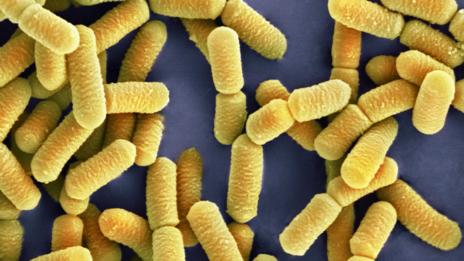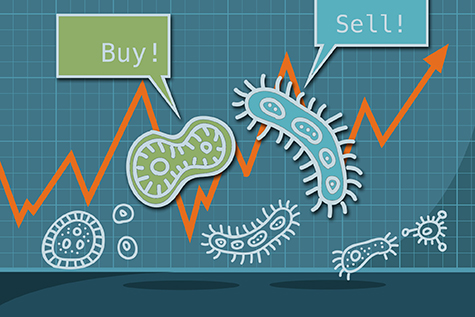Sunday, April 26, 2015
evolution in four dimensions...,
By
CNu
at
April 26, 2015
7
comments
![]()
Labels: evolution , Genetic Omni Determinism GOD , microcosmos , What IT DO Shawty...
Friday, April 24, 2015
scientists discover LEM
“It could be a game-changer for treating a number of different cancers and viruses.
“This is a completely unknown protein. Nobody had ever seen it before or was even aware that it existed. It looks and acts like no other protein.”
The protein – named lymphocyte expansion molecule, or LEM, promotes the spread of cancer killing ‘T cells’ by generating large amounts of energy.
Normally when the immune system detects cancer it goes into overdrive trying to fight the disease, flooding the body with T cells. But it quickly runs out of steam.
By
CNu
at
April 24, 2015
2
comments
![]()
Labels: microbiome , microcosmos , What IT DO Shawty...
inflammatory bowel and ulcerative colitis caused by identified microbe-host interaction
Butt then we told you this five years ago....,
By
CNu
at
April 24, 2015
0
comments
![]()
Labels: microbiome , microcosmos , What IT DO Shawty...
viral proteins regulate human embryonic development
By
CNu
at
April 24, 2015
0
comments
![]()
Labels: microcosmos , symbiosis
Tuesday, April 07, 2015
who owns CRISPR?
By
CNu
at
April 07, 2015
0
comments
![]()
Labels: Genetic Omni Determinism GOD , microcosmos
Saturday, November 08, 2014
gene-centrism vs. multi-level selection
By
CNu
at
November 08, 2014
0
comments
![]()
Labels: Genetic Omni Determinism GOD , microcosmos , symbiosis , What IT DO Shawty...
Tuesday, October 14, 2014
lucy in the sky with diamonds....,
By
CNu
at
October 14, 2014
0
comments
![]()
Labels: microcosmos , Possibilities
Friday, September 05, 2014
the body's ecosystem
By
CNu
at
September 05, 2014
0
comments
![]()
Labels: microcosmos , symbiosis , What IT DO Shawty...
Wednesday, August 13, 2014
cooperative social networking key to helping microbes spread...,
By
CNu
at
August 13, 2014
0
comments
![]()
Labels: microcosmos , symbiosis , tactical evolution , What IT DO Shawty...
behavior and the biome: love and early childhood diarrhea
By
CNu
at
August 13, 2014
0
comments
![]()
Labels: as above-so below , ethology , microcosmos , What IT DO Shawty...
Tuesday, August 12, 2014
voices from within: gut microbes and the central nervous system
By
CNu
at
August 12, 2014
1 comments
![]()
Labels: as above-so below , essence , microcosmos
missing microbes: conspicuously obvious once the man points it out...,
By
CNu
at
August 12, 2014
0
comments
![]()
Labels: as above-so below , common sense , microcosmos , symbiosis
the quantified microbiome visualization looks strangely like an appflow visualization...,
By
CNu
at
August 12, 2014
2
comments
![]()
Labels: microcosmos , symbiosis , tactical evolution
genetic information transfer promotes cooperation in bacteria
By
CNu
at
August 12, 2014
0
comments
![]()
Labels: as above-so below , microcosmos , symbiosis , What IT DO Shawty...
Sunday, July 20, 2014
bacteria that subsist on electricity
By
CNu
at
July 20, 2014
0
comments
![]()
Labels: high strangeness , microcosmos
Friday, April 04, 2014
microbial genes, brain & behaviour – epigenetic regulation of the gut–brain axis
By
CNu
at
April 04, 2014
0
comments
![]()
Labels: Genetic Omni Determinism GOD , microcosmos , symbiosis , What IT DO Shawty...
Saturday, March 01, 2014
biota, diet, brains, power...,
By
CNu
at
March 01, 2014
0
comments
![]()
Labels: food-powered , Genetic Omni Determinism GOD , microcosmos
Thursday, January 30, 2014
microbial market theory...,
By
CNu
at
January 30, 2014
0
comments
![]()
Labels: as above-so below , microcosmos
Monday, December 02, 2013
from dust-to-dust...,
By
CNu
at
December 02, 2013
0
comments
![]()
Labels: ecosystems , Farmer Brown , food supply , microcosmos
Saturday, August 24, 2013
breath straight kicking like cancer....,
By
CNu
at
August 24, 2013
0
comments
![]()
Labels: microcosmos , shameless , subliminal
H.R. 6408 Terminating The Tax Exempt Status Of Organizations We Don't Like
nakedcapitalism | This measures is so far under the radar that so far, only Friedman and Matthew Petti at Reason seem to have noticed it...
-
theatlantic | The Ku Klux Klan, Ronald Reagan, and, for most of its history, the NRA all worked to control guns. The Founding Fathers...
-
Video - John Marco Allegro in an interview with Van Kooten & De Bie. TSMATC | Describing the growth of the mushroom ( boletos), P...
-
Farmer Scrub | We've just completed one full year of weighing and recording everything we harvest from the yard. I've uploaded a s...







